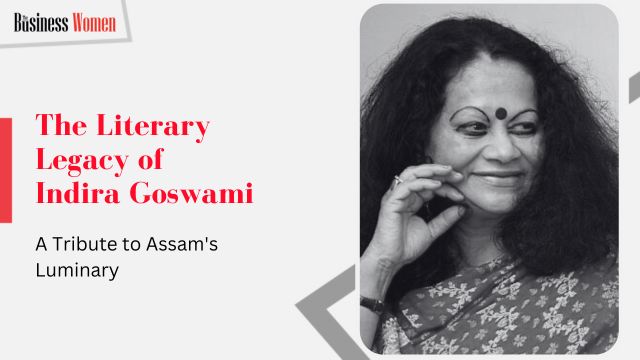Indira Goswami, affectionately known as Mamoni Baideo and renowned by her pen name Mamoni Raisom Goswami, stands as a towering figure in Indian literature, leaving an indelible mark on the cultural landscape. Her remarkable journey from a traditional Vaishnavite Brahmin upbringing in Assam to becoming a celebrated author is a testament to her resilience and literary brilliance.
Early Life and Education
Born on November 14, 1942, in Guwahati, Assam, to Umakanta Goswami and Ambika Devi, Mamoni Goswami was deeply immersed in Assamese culture and literature from an early age. Her literary talents blossomed during her schooling in Guwahati and Shillong. Pursuing her passion, she majored in Assamese literature at Cotton College in Guwahati and obtained a master’s degree from Gauhati University, laying the groundwork for her illustrious literary career.
Writing Career
Mamoni Goswami’s literary journey commenced with her debut collection of short stories, “Chinaki Morom,” written while still a student. Recognising her prodigious talent, editor Kirti Nath Hazarika published her stories when she was just thirteen years old, setting the stage for her prolific career.
Depression and Resilience
Despite grappling with personal demons, including a profound battle with depression, Goswami found solace and strength in her writing. Her autobiography, “The Unfinished Autobiography,” candidly confronts her struggles, including her youth’s brush with suicide. Tragedy struck with the untimely demise of her husband, Madhaven Raisom Ayengar, in a car accident, plunging her into a deep spiral of depression and reliance on sleeping tablets. However, writing emerged as her lifeline, sustaining her through the darkest of times.
Life in Vrindavan
In search of tranquillity, Mamoni Goswami sought refuge in Vrindavan, Uttar Pradesh. During her stay, she penned “The Blue-Necked Braja,” shedding light on the plight of Radhaswamis grappling with poverty and exploitation. The novel poignantly explores the challenges faced by young widows, grappling with moral dilemmas rooted in their religious beliefs.
Life at the University of Delhi
Relocating to Delhi, Goswami joined the University of Delhi as a Professor of Assamese. Her tenure witnessed the creation of significant literary works, with Delhi serving as the backdrop for poignant short stories like “Hridoy,” “Nangoth Sohor,” and “Borofor Rani.” Beyond academia, she ardently advocated for the establishment of a Chair in honour of Assamese saint-philosopher Srimanta Sankardev at Delhi University, underscoring her unwavering commitment to Assamese literature.
Notable Novels and Controversies
Goswami’s literary oeuvre comprises notable novels such as “Pages Stained With Blood” and “The Moth Eaten Howdah of a Tusker,” addressing pressing societal issues. “Pages Stained With Blood” delves into the harrowing aftermath of the 1984 anti-Sikh riots, while “The Moth Eaten Howdah of a Tusker” amplifies the struggles of Assamese Brahmin widows. Her bold critique of the tradition of animal sacrifice in the Kamakhya Temple, portrayed in “The Man from Chinnamasta,” sparked controversy and even threats to her life. Goswami advocated for worshipping the Mother Goddess with flowers rather than blood, embodying her fearless spirit and commitment to social reform.
Autobiography, Poetry, and Non-Fiction
Goswami’s literary repertoire extends beyond novels to encompass diverse genres. Her autobiography, “An Unfinished Autobiography,” along with poetry collections like “Pain and Flesh,” “Pakistan,” and “Ode To A Whore,” and her non-fiction work on the comparative study of Tulsidas’s Ramayana and the Assamese Ramayana titled “Ramayana from Ganga to Brahmaputra,” showcase her versatility and intellectual depth.
Awards and Recognition
Indira Goswami’s literary prowess has been duly recognised with prestigious awards such as the Sahitya Akademi Award in 1982 for “Mamore Dhora Tarowal” and the esteemed Jnanpith Award in 2000. Beyond accolades, she played a pivotal role in facilitating dialogue between the United Liberation Front of Asom and the Government of India, contributing significantly to peace efforts in the region.
Legacy and Conclusion
Indira Goswami fondly remembered as Mamoni Baideo, passed away on November 29, 2011, leaving behind a literary legacy that continues to inspire and resonate with generations. Her ability to transmute personal struggles into potent narratives reflects her enduring impact on the literary landscape. Goswami’s fearless advocacy for social change, coupled with her unwavering dedication to her craft, cements her status as an iconic figure in contemporary Indian literature, whose influence reverberates far beyond her lifetime.








